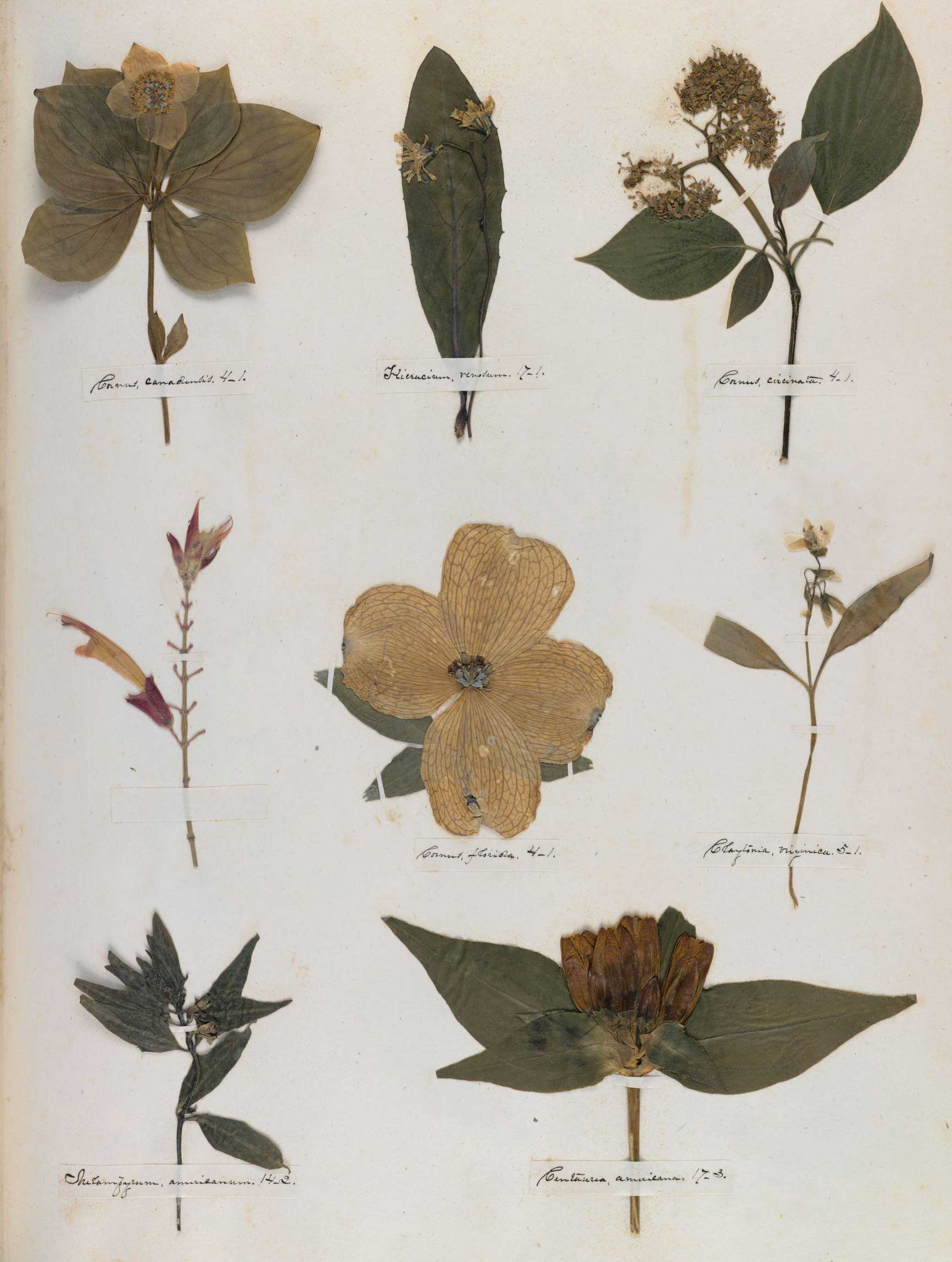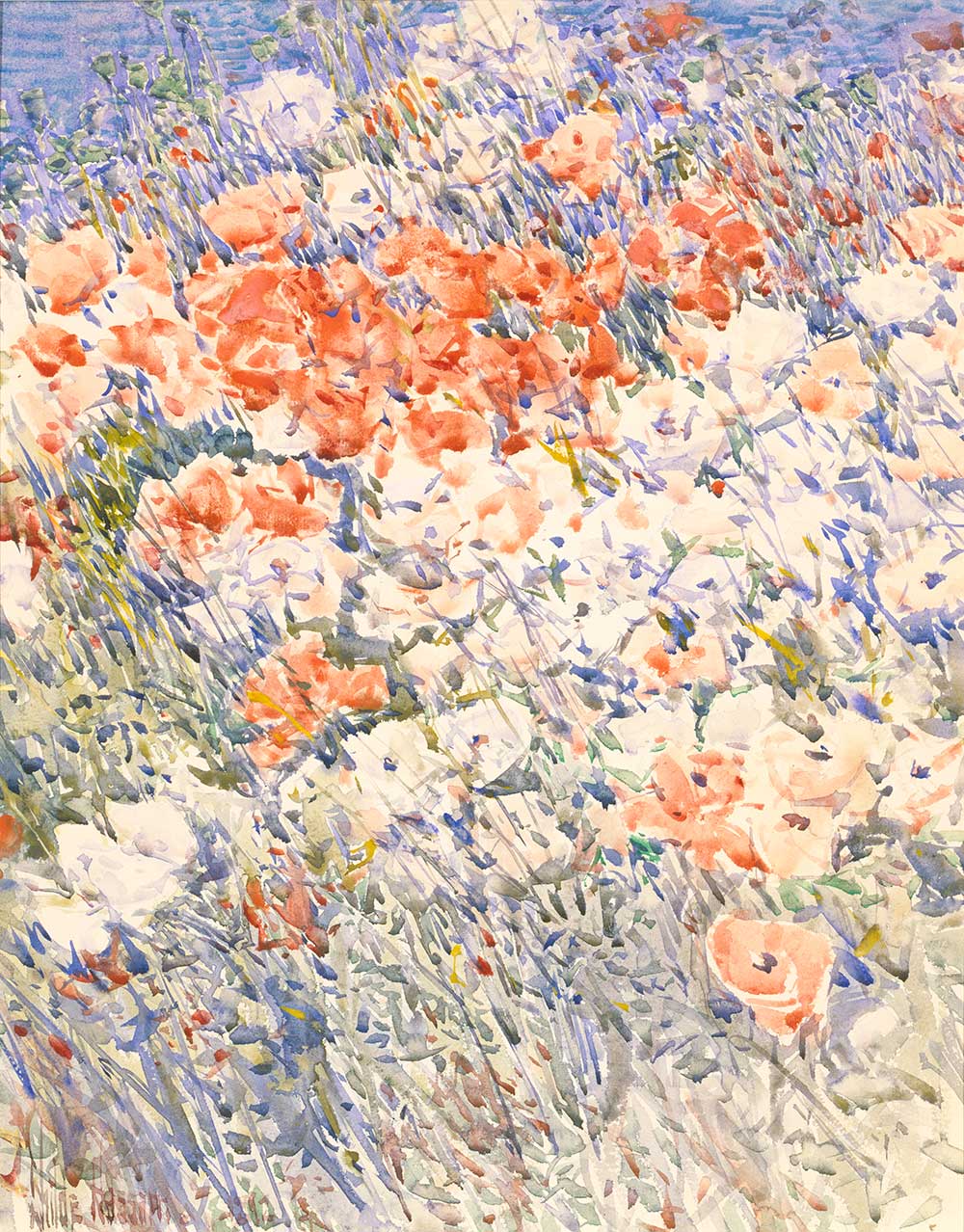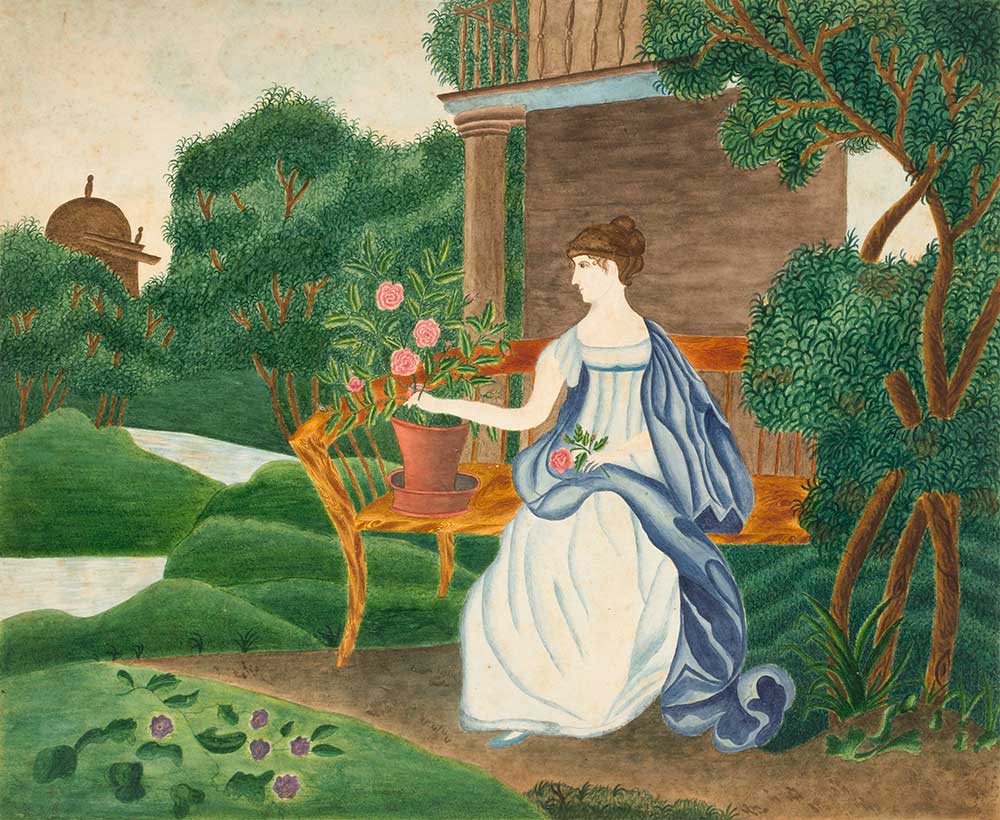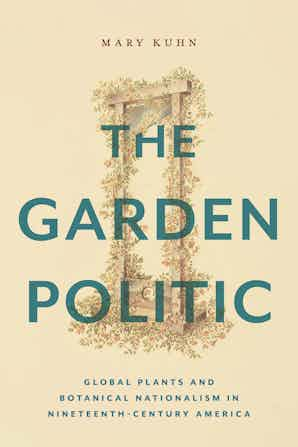
Page from Emily Dickinson’s herbarium, c. 1840. Photograph by Houghton Library. © President and Fellows of Harvard College.
Science, though a very great and learned lady, does not yet know everything. Her elder sister, Poetry, often sees further and deeper into things than she does.
—“Have Plants Intelligence?” All the Year Round, 1870
In 1870 the American Independent ran an article from Charles Dickens’ magazine All the Year Round titled “Have Plants Intelligence?” The provocative question in the title was designed to spark intuitive negative responses, but the paragraphs that follow rehearse a clear argument in the affirmative. Life itself “presupposes in its possessor, whether animal or vegetable, a faculty of sensation that administers to its happiness, and that may consequently administer to its suffering,” the author argues. This meant that plants experience pleasure and pain. Although the author suggests that the scientific community had dismissed the notion of feeling plants, in fact naturalists had been asking and debating this issue for decades, studying plants like the carnivorous flytrap that caught prey and the “sensitive” mimosa that shrank upon touch. By the mid-nineteenth century a number of scientists believed that plants could at least feel, if not think, and their findings were received by audiences whose own experiences cultivating plants had allowed them to observe a stunning array of plant behaviors. In the garden, the parlor, and the greenhouse, plants’ living qualities became an object of fascination and raised questions like the one the article poses rhetorically. How to make sense of the behaviors of plants? Did they have an inner life? It could certainly appear so, though so much remained a mystery.
If the scientific community was not as categorically opposed to the idea of plant feeling as the author implies, the article’s turn to poetry suggests literature might excel at exploring the inherent difficulties in representing this other form of life. As scholar Sari Altschuler has shown, nineteenth-century members of the medical community turned to literature to better understand the mysteries of bodies, diseases, and environments. Could literature likewise yield insight or appreciation for the liveliness of plants?
Emily Dickinson was, by all accounts, a skillful and dedicated gardener. Throughout her isolation at her parents’ house on Main Street in Amherst, Dickinson continued to raise plants, arrange bouquets, and send cuttings to distant friends. As a student she scouted for new flowers to press into her bound herbarium, and in winter, to keep plants warm, she brought them into the conservatory built against the southeastern wall of the house. The structure allowed her to cultivate tropical plants that could not otherwise survive the New England climate. Dickinson knew firsthand how fickle plants could be, and how fragile, and she had skill in growing plants that were not native to the area or suited to the climate. And her many botanical poems take on new meaning when read alongside the circulation of plants across the nineteenth century that made foreign flora accessible to American home gardens. Sentiment and science overlapped in rendering plants intimately strange to nineteenth-century gardeners.
Across her poems and her letters Dickinson dwelled on how the creative energy of the botanical realm might escape, challenge, and in some ways reorganize human-centric designs. In this sense, she departed from dominant theories of natural philosophy that elevated human consciousness above other forms of life, aligning herself instead with an emergent scientific discourse about plant feeling. Whereas the many theories of life in the nineteenth century—like the great chain of being or argument from design—tended to see the world as an orderly and stable hierarchy with humans at the top, Dickinson was among those who found in the plant realm another possibility: life whose very nature is collaborative, decentralized, and communicative with other environmental agents in ways that human actors cannot anticipate or control. Such theories about the organization of plant matter inevitably have political and cultural consequences. If plants are vital, sensible, and mobile, they cease to simply reflect the human values projected upon them. Their autonomy is both difficult to imagine and politically charged, for it elicits an awareness of the limits to human control—and not only control of plants themselves.

By Dickinson’s lifetime, plant sentience was an established, if hotly debated, current of thought within natural history. By the end of the eighteenth century, naturalists hypothesized that plants could feel in ways analogous to human feeling. Whereas Linnaeus distinguished plants from animals in Philosophia Botanica (1751) on the very basis that plants had “growth and life” but no “feeling,” by the time American naturalist William Bartram published his Travels in 1791, his observations led him to conclude that “vegetable beings are endued with some sensible faculties or attributes, similar to those that dignify animal nature.” Calling Dionaea muscipula (Venus flytrap) “sportive” and noting the “artifice” with which they “entrap incautious deluded insects,” Bartram perceived plants as like humans in certain respects and indeed compares climbing vines to “the fingers of a human hand.” As academic Michael Gaudio notes, such a doctrine of plant feeling made sense in an Enlightenment context in which the natural and the social “were understood to operate according to the same principles.”
By the early decades of the nineteenth century scientists increasingly strove to detach subjectivity from empirical analysis, positioning the natural and the social further apart. Discussions of plant feeling among nineteenth-century botanists reveal ambivalence about the affinities between plants and humans. Many were willing to concede plant sentience but diverged widely on how to understand it. Georges Cuvier clearly limited the likeness between plant and animal, whereas Charles Darwin’s research into plant motion led him to conclude that the root of a plant “acts like the brain of one of the lower animals.” Augustin de Candolle, who dropped acid onto plant leaves to test their irritability and responsiveness, did not grant plants a close relationship to humans but declared that “plants live, not merely in the common sense of the word, which includes activity of every kind, but in that stricter sense, by which a higher and self-dependent activity is expressed.” And Harvard botanist Asa Gray, whose work Dickinson knew, vacillated over several decades but edged toward a theory of plant intelligence, titling his 1872 children’s botany textbook How Plants Behave: How They Move, Climb, Employ Insects to Work for Them, &c. As one 1873 review of the book noted, Gray’s language “goes far toward warranting the opinion that plants are sentient creatures. If this be so, what a world of strange revelations awaits some fortunate investigator! He—or the boon may fall to the lot of a woman—will tell us if it be true that plants have pleasures and pains, that they weep when bruised, that they sleep at night, that, like the Vallisneria spiralis, all flowers love…We might say that in the very title of his book Prof. Gray concedes the sensibility of plants, and half admits their intelligence.” Beyond granting female botanical authority, the reviewer reveals the extent to which this book potentially opens the door to a new paradigm of thought about plant life, one granted authority through scientific investigation. “To behave,” so the reviewer crucially continues, “implies a knowledge of propriety; and if plants approach humanity so closely, it would seem absurd to deny their near relationship.”
A number of popular journals helped disseminate these ideas to a broader audience. An 1863 article in the Horticulturalist asks bluntly, “Is the plant stupid?” The author extols plant intelligence: “Who will now undertake to say that a plant is not sensible? If you go into the fields, you will tread upon a multitude of flowers that know better than you do which way the wind blows, what o’clock it is, and what is to be thought about the weather.” An 1873 article in the Youth’s Companion on plant sleep notes that “the deeper we search into the mysteries of vegetable life, the closer appears its relations to animal existence. Botanists—especially among the French—assert that plants breathe, work, sleep, are sensitive and capable of movement. These points lead to debatable ground.” This “debatable ground” is the extent to which commonality exists between plants and animals and was contested because its implications were so potentially explosive. To follow the debate to its most radical social conclusions—a point before which most writers stopped—might be to concede plant life is intelligently organized in a manner that might entail ethical and epistemological demands on humans.
In making the popular argument that readers should consider the idea of plant intelligence, many articles pointed to evidence in literary and religious texts dating back centuries. The author of “Have Plants Intelligence?” gestures at Ovid and Hafez as well as Roman mythology and Greek superstition to counter Linnaeus’ claim that plants lack feeling, observing that science’s “elder sister, Poetry, often sees further and deeper into things than [science] does.” Another article on “The Soul of Plants” for Appleton’s Journal cites Anaxagoras, Pythagoras, and Plato among those who believed in the existence of “an intelligent principle, or soul, in plants.” To support this idea the author describes a number of experiments on plant sensitivity, reaching back to Pliny the naturalist’s observation of a tree whose leaves drooped when touched. In reaching back into the past to support contemporary ideas about plant intelligence, both articles suggest the extent to which contemporary science might look to poetry for insight into the mysteries of plant life.
The fraught nature of the debate over plant sentience in part hinges on the ways in which plants model life itself differently. Competing theories about the nature of life were widespread in the nineteenth century, offering a somewhat chaotic and contradictory range of ideas about where liveliness originates and how it is organized. Benjamin Rush believed in what literary scholar Monique Allewaert has termed “vitalist materialism”: a theory that matter has a capacity for life but requires external stimuli. For Samuel Taylor Coleridge, life occurs when a supernatural force—a kind of spiritual antecedent—animates nature. Thoreau condemns the physiologist “in too much haste to explain [plant] growth according to mechanical laws” and muses that “the mystery of the life of plants is kindred with that of our own lives.” He urges a kind of restraint toward the question of life itself, arguing that “we must not presume to probe with our fingers the sanctuary of any life, whether animal or vegetable; if we do we shall discover nothing but surface still, or all fruits will be apples of the Dead Sea, full of dust and ashes.”

As discussion of plant vitality broadened, the distance between literary and scientific ideas about plant life narrowed. An 1878 article in the Eclectic Magazine of Foreign Literature makes the point about plant perception more poetically and definitively. William Wordsworth’s “belief…‘that every flower / Enjoys the air it breathes’ ” had in fact been validated by “the rapid march of investigation within recent years [that] transformed a poetic thought into a dictum of natural science.” Experiments with food, locomotion, and sensitivity had pointed biologists toward the overwhelming conclusion that the essential characteristics of plants and animals could not be easily or confidently distinguished. Part of the confusion stems from the creation of categories, for if differences might be clearly discernible “between the higher animals and plants,” still “any definition of an animal or of a plant, to be either satisfactory or useful to the scientific man or to mankind at large, must include all animals and all plants.” Such broad categories produce strange bedfellows, as historian Harriet Ritvo has noted with animal classification, and point to the ways in which botanical research in the second half of the nineteenth century did not simply seek to reify Linnaean order but rather continued to revise the way in which life was conceptualized, organized, and understood. Beyond her access to a number of prominent periodicals, Dickinson directly encountered theories of plant sentience in a number of ways. The botany that Dickinson learned as a schoolgirl was mainly taxonomic, but even botanical educators who sought to teach students easy means of classifying nature conceded that the line between plants and animals was at least somewhat blurry. Almira Lincoln Phelps, the author of the most popular botanical textbook in nineteenth-century America, acknowledged the “almost imperceptible gradations by which the animal and vegetable kingdoms are blended.” Toward the end of Familiar Lectures on Botany, a textbook Dickinson used, Phelps furthermore attributed sensation and instinct to plants even as she qualified their “principle of life” relative to that of animals. The geologist Edward Hitchcock, who taught natural sciences at Amherst College and whose book on local flora Dickinson also used, likewise believed the subject to be important enough to raise in his introductory lecture on botany, noting that “the lowest tribe of animals comes nearest to the lowest order of plants. This destroys the idea of a regular chain.”
Prompted by her friend and distant cousin William, Dickinson also read X.B. Saintine’s popular 1836 novel Picciola, which recounts a prisoner’s obsession with the plant growing in his prison courtyard—an obsession that takes the form of compassionate care and empirical analysis of the plant. The prisoner’s redemption lies in his studious love of the plant, which he calls his “benefactress,” and with which he comes to feel a “mysterious sympathy of nature.” In a letter to her cousin thanking him for sending her the book, Dickinson conflates book with plant: “ ’Tis the first living thing that has beguiled my solitude, & I take strange delight in its society.”
To engage the matter of plant liveliness, Dickinson’s approach to organic matter combines scientific knowledge with a sentimentalism often considered antithetical to empirical study. For Dickinson, shared sentiment might become a way to connect the human condition to that of birds, flowers, and the natural environment at large. In “The Birds Reported from the South—” this rapport becomes increasingly intimate:
The Birds reported from the South—
A News express to Me—
A spicy Charge, My little Posts—
But I am deaf—Today—
The Flowers—appealed—a timid Throng—
I reinforced the Door—
Go blossom to the Bees—I said—
And trouble Me—no More—
The Summer Grace, for notice strove—
Remote—Her best Array—
The Heart—to stimulate the Eye
Refused too utterly—
At length, a Mourner, like Myself,
She drew away austere—
Her frosts to ponder—then it was
I recollected Her—
She suffered Me, for I had mourned—
I offered Her no word—
My Witness—was the Crape I bore—
Her—Witness—was Her Dead—
Thenceforward—We—together dwelt—
She—never questioned Me—
Nor I—Herself—
Our Contract
A Wiser Sympathy
The poem refuses a firm distinction between the civic and the natural through language that overlays the conflict of the Civil War—the reports from the South, the “News,” the “spicy Charge”—with the progression of the seasons. Not wholly distinct from human affairs, nature is also no mere mirror of the speaker’s inner mournful state, but “A Mourner, like myself.” Nature is a sensible agent that strives for notice, draws away austerely, and ponders her own frosts. We could read this as simple anthropomorphism or the pathetic fallacy, connecting the outer world to the speaker’s inner turmoil, except for the fact that the poem tracks the discord between the speaker and nature before “I recollected Her—,” making nature’s emotions autonomous.
By refusing the rigid separation of human, animal, and plant, the poem unsettles a fundamental premise that shaped nineteenth-century conceptions of personhood. That the speaker shares a sympathetic contract not with other humans but with nature invites identification across category distinctions. How the line gets drawn between sentience and sensibility, between raw physiological feeling and discernment, mattered in nineteenth-century America because taste had such political purchase. In William Huntting Howell’s words, “Understanding sensibility promised to answer the question of what counts as personhood.” But what if sensibility did not only “index humanity” per se? Dickinson’s perspective on flora blurs the boundary between human and plant by at times making sentiment a character trait that she shares with the natural world, rather than merely an aesthetic stance toward that world.
Excerpted from The Garden Politic: Global Plants and Botanical Nationalism in Nineteenth-Century America by Mary Kuhn, reprinted with permission from New York University Press. © 2023 by New York University.
